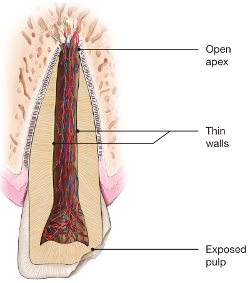What If My Child’s Tooth Is Knocked out at Baseball Practice?
Treatment of Traumatic Dental Injuries and Replantation
Out in the real world, people of any age may experience traumatic dental injuries in an accident or during a sports-related injury. Chipped teeth account for most dental injuries, followed by dislodged or knocked-out teeth, which are more severe injuries. It’s a good idea to seek an immediate examination by a dentist or an endodontist to get prompt treatment. Surrounding teeth or structures may be affected, requiring a thorough dental exam.
Our endodontists here at Endodontic Assoicates specialize in treating traumatic dental injuries. Our collective advanced skills, techniques and technologies often save injured teeth. If you have a cracked or injured tooth, you can call us and we’ll accommodate emergency cases, including weekends in some cases, so your pain can be relieved quickly.
How Will My Dental Injury Be Treated?
Chipped or Fractured Teeth
Most chipped or fractured tooth crowns can be repaired either by reattaching the broken piece or by using a tooth-coloured filling. If the damage of the tooth crown is a large area, an artificial crown or “cap” may be needed to repair the tooth.
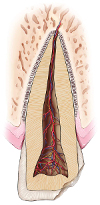
If the pulp is damage or exposed after a crown fracture, root canal treatment may be needed. These injuries require special attention by a dentist. If sucking in air through your mouth or drinking cold fluids is painful, bite on clean, moist gauze or cloth to help relieve symptoms until reaching your dentist’s office. Never use topical oral pain medications or ointments, or place aspirin on the affected areas to eliminate pain symptoms.
Injuries in the back teeth often include fractured cusps, cracked teeth and the more serious split tooth. If cracks extend into the root, root canal treatment and a full coverage crown may be needed to “hold the tooth together” to restore function to the tooth. Split teeth may require extraction.
Dislodged (Luxated) Teeth
A forceful mouth injury may push a tooth sideways, out of, or into its socket. The endodontist or general dentist will reposition and stabilize your tooth. Root canal treatment is usually needed for permanent teeth that have been dislodged. Timely treatment is best started a few days following the injury. Healing medications may be put inside the tooth as part of the root canal treatment. A permanent root canal filling will be placed at a later date.
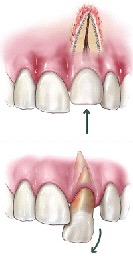
Children between seven and 12 years old may not need root canal treatment since their teeth are still developing and may be more resilient in the healing process. The child’s endodontist or dentist will monitor the healing process carefully to watch for unfavourable changes in the afflicted tooth. A series of follow-up appointments are likely to be needed after the initial treatment. Research indicates that stem cells present in the pulps of young people can be stimulated to complete root growth and heal the pulp following injuries or infection.
What to Do If the Tooth Is Entirely Knocked out (Avulsed)?
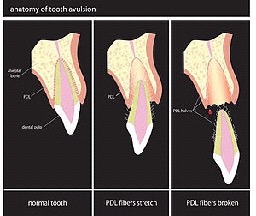
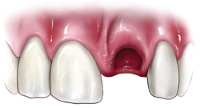
If a tooth is completely knocked out of your mouth, time is of the essence. See an endodontist or dentist immediately! Handle the knocked-out tooth very gently, avoiding touching the root surface, and take these precautions:
Steps to saving a knocked-out tooth:
1. Pick up the tooth by the crown (the chewing surface) NOT the root.
Locate the tooth immediately; do not leave it at the site of the accident. The tooth should be handled carefully. Touch only the crown to minimize injury to the root.
2. If dirty, gently rinse the tooth with water.
- Do not use soap or chemicals.
- Do not scrub the tooth.
- Do not dry the tooth.
- Do not wrap the tooth in a tissue or cloth.
3. Reposition the tooth in the socket immediately, if possible.
The sooner the tooth is replaced, the greater the likelihood it will survive. To reinsert, carefully push the tooth into the socket with your fingers, or position above the socket and close your mouth slowly. Hold the tooth in place with your fingers or by gently biting down on it.
4. Keep the tooth moist at all times.
The tooth must not be left outside the mouth to dry. If it cannot be replaced in the socket, put it in one of the following:
- Emergency tooth preservation kit (such as Save-a-Tooth®)
- Milk
- Mouth (next to cheek)
- Regular tap water is not recommended for long-term storage because the root surface cells do not tolerate water for long periods of time.
Your endodontist or dentist will carefully evaluate the tooth, place it back in its socket and examine you for any other dental and facial injuries. A stabilizing splint will be placed for a few weeks. Depending on the stage of root development, your dentist or endodontist may start root canal treatment a week or two later. A medication may be placed inside the tooth followed by a permanent root canal filling at a later date.
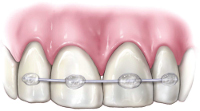
The length of time the tooth was out of the mouth and the way the tooth was stored before reaching the dentist influence the chances of saving the tooth. Again, immediate treatment is essential. Taking all these factors into account, your dentist or endodontist may discuss other treatment options with you.
Root Fractures
Traumatic injury to the tooth may also result in a horizontal root fracture. The location of the fracture determines the long-term health of the tooth. If the fracture is close to the root tip, the chances for success are much better. However, the closer the fracture is to the gum line, the poorer the long-term success rate. Sometimes, stabilization with a splint is required for a period of time.
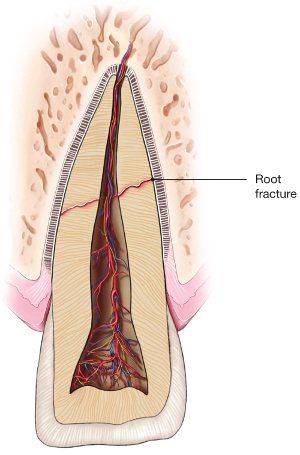
Do Traumatic Dental Injuries Differ in Children?
Typically, a primary or baby tooth is not replanted. The process of replantation may cause damage to the developing permanent tooth growing inside the bone. An injury to developing teeth needs careful follow up. Many times, the tooth will heal itself and a damaged root may continue to develop because of the presence of stem cells and a robust blood supply inside the tooth.
Your endodontist will do all that is possible to save the natural tooth and provide expertise and advice for a child who has had a dental injury to developing teeth.
